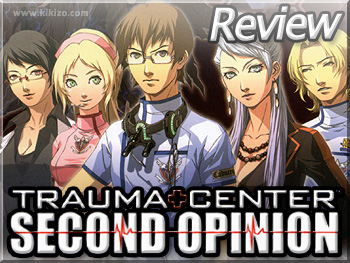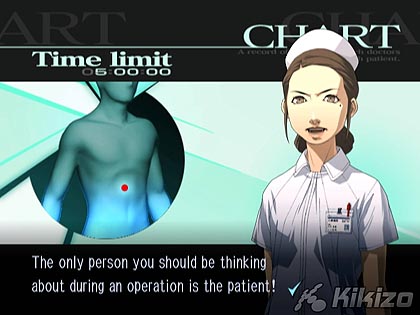Trauma Center: Second Opinion
Not our second opinion, but ours nonetheless.
| Version Wii | Developer Atlus | Publisher Nintendo | Genre Adventure |
||||
Those crazy Japanese, eh? Just where do they get their inspiration from? In the case of Trauma Center it's easy to see if you look hard enough. Take for instance your first patient, Mr. Kevin Turk. Surely a reference to Scrubs' very own Dr. Turk? What about your second patient, Noah Laurie? An obvious mash-up of Noah Wyle from ER fame and Hugh Laurie of House? Then there's a certain Mr. Elliot Cox - yet again a character from Scrubs. One would assume that American prime-time medical dramas are staple viewing over in Japanese households judging by the number of references included in Trauma Center: Second Opinion. Which is fine as long as they don't start including adverts every 10 minutes.

There's no sign of such annoyances yet though, at least not in this highly polished remake of the DS original. Based upon Under The Knife, this update is essentially the same only with Wii specific features, some additional missions and of course, improved audio and visuals. Control has obviously been tailored for the Wii's remote and nunchuk as opposed to the DS's stylus and as such is as simple as possible but no simpler. An array of medical tools are at your disposal and these are indicated by an octagon at the bottom left of the screen. To select a tool is simply a matter of moving the nunchuk's analogue stick in the required direction. There are also one-off tools to use which only appear in certain situations, such as bandages after you have sutured a patient. These can be picked up by simply pointing and clicking on them with the remote.
The precision and control afforded by your pin-point on-screen marker is exemplary and should assuage any remaining doubters, once again validating Nintendo's choice of input device. Each procedure requires a combination of steps, often within a time limit and some needing more precision than others. The scalpel for instance, is used to cut patients open and generally an accurate line must be followed in order to obtain a 'good' or 'cool' mark. Before making an incision though, you must disinfect the area with the antibiotic tool which is more forgiving in its accuracy, covering a wider area.
Forget to apply the antibiotic and you can still make the incision but will score a 'bad' rating and cost the patient some of his vitals. This combination of tools and precision leads to some frantic moments as you attempt to perform the required procedure before you lose the patient completely. It is all too easy in the heat of the moment to forget what is required of you to complete the operation and save patient. Thankfully this is only a game!
Luckily your trusty nurse will walk you through most procedures to begin with, although as the levels progress she only provides basic instructions and even chiding should you make an error. The characters and plot all hang neatly together in an intriguing story which has been grafted onto the game. Assuming the role of Derek Stiles, you play as a doctor at Hope Hospital, one whom takes his position of importance in a rather haphazard manner. This is until he nearly loses a patient due to negligence and, upon taking time out to find himself, stumbles upon the scene of a car crash.
With a renewed vigour he returns to the hospital determined to save these patients' lives. It is then he finds a power within him - the Healing Touch, reputedly afforded to descendants of Ascelpius, the Greek god of medicine. Once this move has been unlocked and practised, it can be called upon in any operation by drawing an on-screen star. The accuracy of this star determines how well the Healing Touch is performed and thus how much time slows down, allowing you to perform more procedures with the patient loosing less vitals.
Presentation throughout the game is top-notch, with the story told via static cut-scenes. Whilst the Wii might be derided for its lack of graphical fidelity, here the visuals are exactly what they need to be. It is in the control method however, where the game really shines. Imagine playing Trauma Center on any standard analogue-stick control pad is akin to giving the game a kiss of death, robbing it of its life and soul.
If games with guns really make us all crazed killers, wouldn't it be great if Trauma Center made us all life-savers? Those crazy Japanese - just what will they think of next?
| ||||||||||||
|















 Satoru Iwata Video Interview - the late Nintendo president spoke with Kikizo in 2004 as 'Nintendo Revolution' loomed.
Satoru Iwata Video Interview - the late Nintendo president spoke with Kikizo in 2004 as 'Nintendo Revolution' loomed. Kaz Hirai Video Interview - the first of Kikizo's interviews with the man who went on to become global head of Sony.
Kaz Hirai Video Interview - the first of Kikizo's interviews with the man who went on to become global head of Sony. Ed Fries Video Interview - one of Xbox's founders discusses an epic journey from Excel to Xbox.
Ed Fries Video Interview - one of Xbox's founders discusses an epic journey from Excel to Xbox. Yu Suzuki, the Kikizo Interview - we spend time with one of gaming's most revered creators.
Yu Suzuki, the Kikizo Interview - we spend time with one of gaming's most revered creators. Tetris - The Making of an Icon: Alexey Pajitnov and Henk Rogers reveal the fascinating story behind Tetris
Tetris - The Making of an Icon: Alexey Pajitnov and Henk Rogers reveal the fascinating story behind Tetris Rare founders, Chris and Tim Stamper - their only interview? Genuinely 'rare' sit down with founders of the legendary studio.
Rare founders, Chris and Tim Stamper - their only interview? Genuinely 'rare' sit down with founders of the legendary studio. The History of First-Person Shooters - a retrospective, from Maze War to Modern Warfare
The History of First-Person Shooters - a retrospective, from Maze War to Modern Warfare